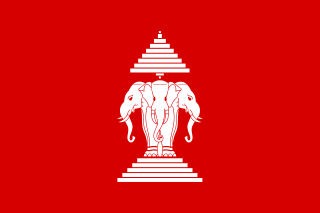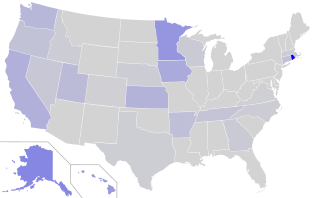| |||||
| Decades: | |||||
|---|---|---|---|---|---|
| See also: | Other events of 1952 List of years in Laos | ||||
The following lists events that happened during 1952 in Laos .
| |||||
| Decades: | |||||
|---|---|---|---|---|---|
| See also: | Other events of 1952 List of years in Laos | ||||
The following lists events that happened during 1952 in Laos .

Laos, officially the Lao People's Democratic Republic, is the only landlocked country in Southeast Asia. It is bordered by Myanmar and China to the northwest, Vietnam to the east, Cambodia to the southeast, and Thailand to the west and southwest. Its capital and most populous city is Vientiane. The country is characterized by mountainous terrain, Buddhist temples including the UNESCO World Heritage site of Luang Prabang, and French colonial architecture.

The Hmong people are an indigenous group in East Asia and Southeast Asia. In China, the Hmong people are classified as a sub-group of the Miao people. The modern Hmong reside mainly in Southwestern China and Mainland Southeast Asian countries such as Vietnam, Laos, Thailand, and Myanmar. There are also diaspora communities in the United States, Australia, and South America.

The Ho Chi Minh Trail, also called Annamite Range Trail was a logistical network of roads and trails that ran from North Vietnam to South Vietnam through the kingdoms of Laos and Cambodia. The system provided support, in the form of manpower and materiel, to the Viet Cong and the People's Army of Vietnam (PAVN), during the Vietnam War. Construction for the network began following the North Vietnamese invasion of Laos in July 1959. At the time it was believed to be the main supply route, however it later transpired that the Sihanouk Trail which ran through Cambodia was handling significantly more material.

The Lao people are a Tai ethnic group native to Southeast Asia. They primarily speak the Lao language, which belongs to the Kra–Dai language family. Lao people constitute the majority ethnic group of Laos, comprising 53.2% of the country's total population. They are also found in significant numbers in northeastern Thailand, particularly in the Isan region, as well as in smaller communities in Cambodia, Vietnam, and Myanmar.

The Kingdom of Laos was the form of government in Laos from 1947 to 1975. Located in Southeast Asia at the heart of the Indochinese Peninsula, it was bordered by Burma and China to the northwest, North Vietnam to the east, Cambodia to the southeast, and Thailand to the west and southwest. The country was governed as a constitutional monarchy beginning with its independence on 22 October 1953. It survived until December 1975, when its last king, Sisavang Vatthana, surrendered the throne to the Pathet Lao during the civil war in Laos, who abolished the monarchy in favour of a Marxist–Leninist state called the Lao People's Democratic Republic, which has controlled Laos ever since.

Luang Phabang, or Louangphabang, commonly transliterated into Western languages from the pre-1975 Lao spelling ຫຼວງພຣະບາງ as Luang Prabang, literally meaning "Royal Buddha Image", is a city in north central Laos, consisting of 58 adjacent villages, of which 33 comprise the UNESCO Town of Luang Prabang World Heritage Site. It was listed in 1995 for unique and remarkably well preserved architectural, religious and cultural heritage, a blend of the rural and urban developments over several centuries, including the French colonial influences during the 19th and 20th centuries.

The Pathet Lao, officially the Lao People's Liberation Army, was a communist political movement and organization in Laos, formed in the mid-20th century. The group ultimately gained control over the entire country of Laos in 1975, after the Laotian Civil War. The Pathet Lao were always closely associated and dependent on Vietnamese communists and North Vietnam since their foundation, with the group being established after advice from Hanoi to create a Laotian counterpart of the Viet Minh or Viet Cong. During the civil war, it was effectively organised, equipped and even led by the People's Army of Vietnam (PAVN). They fought against the anti-communist forces in the Vietnam War. Eventually, the term became the generic name for Laotian communists. Under orders from Mao Zedong, the People's Liberation Army provided 115,000 guns, 920,000 grenades and 170 million bullets, and trained more than 700 of its military officers.

The Laotian Civil War was waged between the Communist Pathet Lao and the Royal Lao Government from 23 May 1959 to 2 December 1975. The Kingdom of Laos was a covert theater during the Vietnam War with both sides receiving heavy external support in a proxy war between the global Cold War superpowers. The fighting also involved the North Vietnamese, South Vietnamese, American and Thai armies, both directly and through irregular proxies. The war is known as the Secret War among the American CIA Special Activities Center, and Hmong and Mien veterans of the conflict.

Laotian Americans are Americans who trace their ancestry to Laos. Laotian Americans are included in the larger category of Asian Americans. The major immigrant generation were generally refugees who escaped Laos during the warfare and disruption of the 1970s, and entered refugee camps in Thailand across the Mekong River. They emigrated to the United States during the late 1970s and throughout the 1980s.

The Laos national association football team represents Laos in association football and is governed by the Lao Football Federation.

Theravada Buddhism is the largest religion in Laos, which is practiced by 66% of the population. Lao Buddhism is a unique version of Theravada Buddhism and is at the basis of ethnic Lao culture. Buddhism in Laos is often closely tied to animist beliefs and belief in ancestral spirits, particularly in rural areas.

Lao-Lao is a Laotian rice whisky produced in Laos. Along with Beerlao, lao-Lao is a staple drink in Laos.

The French protectorate of Laos was a French protectorate in Southeast Asia of what is today Laos between 1893 and 1953—with a brief interregnum as a Japanese puppet state in 1945—which constituted part of French Indochina. It was established over the Siamese vassal, the Kingdom of Luang Phrabang, following the Franco-Siamese crisis of 1893. It was integrated into French Indochina and in the following years further Siamese vassals, the Principality of Phuan and Kingdom of Champasak, were annexed into it in 1899 and 1904, respectively.

Thongloun Sisoulith is a Laotian politician and historian who is serving as the general secretary of the Lao People's Revolutionary Party and the seventh president of Laos since 2021. Previous, he was the 17th prime minister from 2016 to 2021 under President Bounnhang Vorachit.

This article details the fixtures and results of the Laos national football team.

Vientiane is the capital and largest city of Laos. Situated on the banks of the Mekong River at the Thai border, it comprises the five urban districts of Vientiane Prefecture and had a population of 840,000 as of the 2023 Census. Established as the capital of the Lan Xang Kingdom in 1563, Vientiane served as the administrative center during French rule and retains colonial-era architecture alongside Buddhist landmarks such as Pha That Luang, a national symbol of Buddhism, and Haw Phra Kaew, which once housed the Emerald Buddha until its 18th-century relocation to Thailand.

Visitors to Laos must obtain a visa from one of the Laotian diplomatic missions unless they are citizens of one of the visa-exempt countries or citizens eligible for a visa on arrival or an e-Visa. All visitors must hold a passport valid for 6 months.
The following tables present the ranks of the Lao People's Armed Forces, which, as a former French dominion, follow a rank system similar to those used by the French Armed Forces. The design closely follows the Soviet pattern, with two important exceptions: 1) senior officers have a broad coloured stripe instead of two narrow stripes used in the Soviet model; 2) stars are of equal size for all the ranks.
This is a list of Laos representatives at major international beauty pageants: Miss Universe, Miss World, Miss International, Miss Earth. And other international beauty pageants such as Miss Supranational, Miss Grand International and Miss Intercontinental
The COVID-19 pandemic in Laos is part of the worldwide pandemic of coronavirus disease 2019 caused by severe acute respiratory syndrome coronavirus 2. On 24 March 2020, Laos became the last country in Southeast Asia to report its confirmed case of the virus. As of 5 June 2022, there were a total of 210,081 cases and 756 deaths. On 4 May 2021, Laos exceeded 1,000 cases of COVID-19. Five days later, the country recorded the first death.